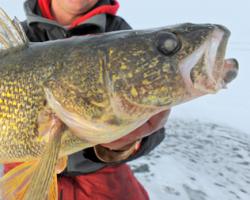Changes Proposed for South Dakota’s Lake Oahe Walleye Regs
Category: npaa
Oct 22nd, 2012 by OutdoorsFIRST
Modified Oct 22nd, 2012 at 12:00 AM
DEADWOOD, S.D. – The South Dakota Game, Fish, and Parks Commission has proposed changes to walleye harvest regulations for Lake Oahe.
 |
|
|
|
Included in the proposal is an increase in the daily bag limit to eight walleyes per day, of which only four can be 15 inches or longer, and eliminating the rule allowing only one walleye over 20 inches daily. The possession limit would be increased to 24 walleyes, or three times the proposed daily limit.
GFP staff recommended the changes for Lake Oahe in response to the effects of last year’s flooding, when record releases of water from Oahe Dam flushed a large number of rainbow smelt out of the lake.
“Rainbow smelt are the primary prey fish for Lake Oahe walleyes, and reduced smelt abundance has resulted in an imbalance between smelt and walleye,” said Mark Fincel, a senior fisheries biologist. “Larger walleyes have shown a sharp decline in condition – or plumpness – due to the relative lack of food. Additionally, highly abundant smaller walleyes of less than 15 inches are also showing a decline in condition.”
A similar event occurred in the late 1990s when high walleye abundance, combined with low smelt abundance, resulted in skinny walleyes. Fisheries staff realized an imbalance between smelt and walleyes and recommended a regulation change to allow increased harvest (bag limit of 14 walleyes, as opposed to the current daily limit of four) to reduce walleye abundance and make it easier for smelt to repopulate.
“While the walleye harvest increased following the rule change, natural mortality had a greater effect on lowering walleye abundance,” Fincel said.
The smelt population rebounded a few years later, and the walleye population soon followed, he said.
“It is believed that smelt abundance increased because conditions were favorable for successful spawning and growth of young smelt — not that enough walleyes were removed from Oahe to allow smelt to recover, Fincel said.
Allowing the high harvest of young walleyes when abundance was high presented an opportunity for anglers to keep more fish at a time when it would not hurt the Oahe walleye population.
“The proposed changes for 2013 are a way to provide extra opportunities for anglers to harvest walleyes that may be lost due to higher than normal natural mortality in the near future,” Fincel said. “Some of the larger walleyes will likely start dying from starvation, and this regulation will allow anglers to harvest some of those fish before they are lost.”
The increased walleye limits will allow increased harvest of young, abundant walleyes that will likely make up the bulk of the catch nest year from Lake Oahe.
The increased possession limit is aimed at providing weekend anglers the ability to harvest and transport 24 walleyes.
“With a four-fish daily limit, many weekend anglers (those with three-day licenses) consumed part of their catch during their trip, allowing for additional harvest on their third angling day. Increasing the possession limit will allow the increased harvest to take place without the need to consume large quantities of walleyes during a trip.
“It is crucial to understand that increasing the daily and possession limits are not an attempt to “fix” the unbalanced predator/prey ratio; it is simply an attempt to use an abundant resource without doing any harm to the resource,” Fincel said. “The public input process is vital in determining acceptance by anglers across South Dakota of this recommended rules change.”
Members of the public can submit comments on the proposed changes, either orally or in writing (or both) at the Nov. 1 commission meeting. Those who are unable to attend the hearing may mail their comments to the Office of the Secretary; Department of Game, Fish and Parks; Foss Building; 523 East Capitol Ave.; Pierre, South Dakota 57501, or via email to [email protected] .
All written and email comments must be delivered at least three days before the Nov. 1 meeting and must include the name and mailing address of the person submitting the comments. To view all of the proposed changes, visit http://gfp.sd.gov/agency/commission/docs/notice.pdf